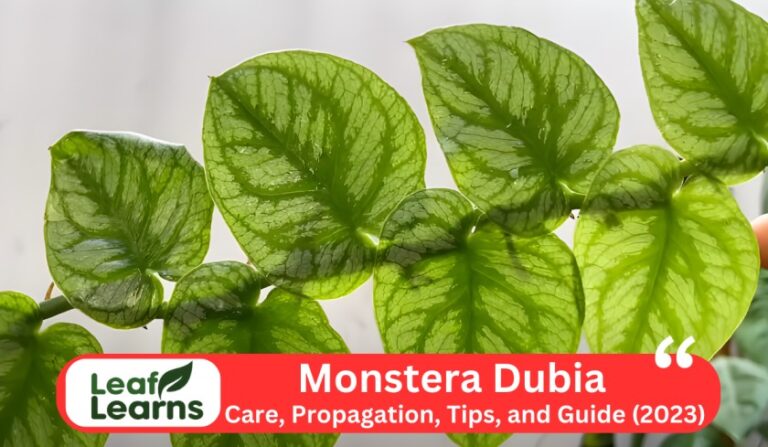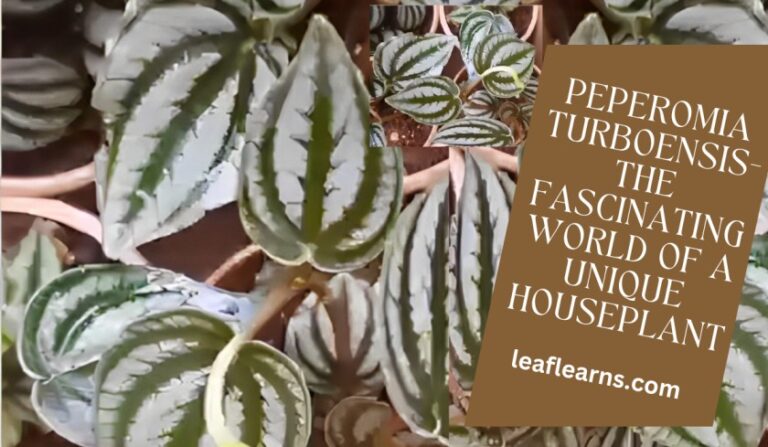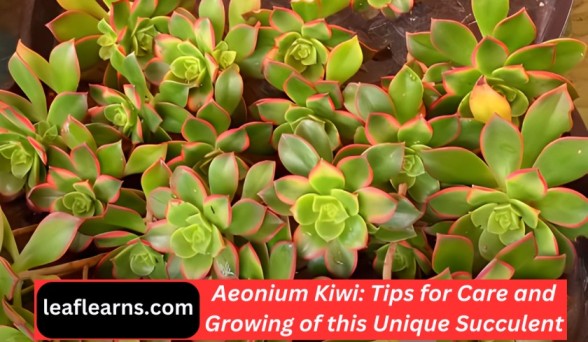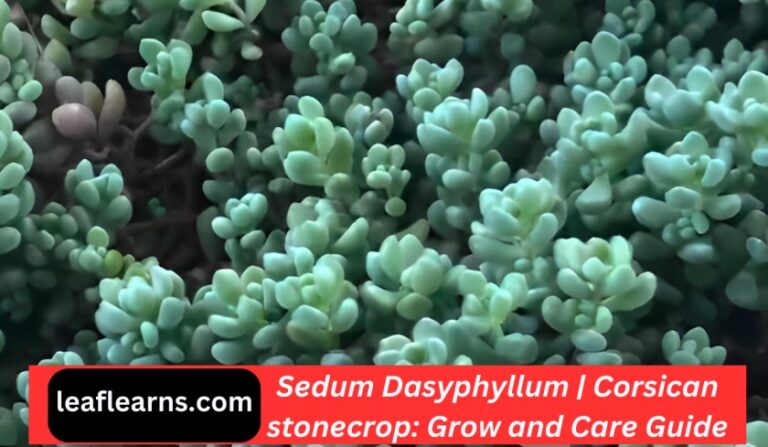Philodendron sodiroi: Best Care, Propagation and Guide (2023)
A tropical plant native to Ecuador called Philodendron sodiroi is referred to as the Ecuador Philodendron or Velvet Leaf Philodendron. This beautiful plant may grow up to 10 feet tall and has huge, heart-shaped leaves with attractive white to silver veins and dark green coloring. It is a great option for an attractive houseplant because of its velvety-textured leaf.

It can grows in strong, indirect light. Maintain high humidity levels, keep the soil regularly moist but not soggy, and provide it with balanced liquid fertilizer during the growth season to maintain its health. Take careful while putting this plant in the home.
However, as it is poisonous to both pets and people if ingested. This plant will bring a sense of tropical beauty to any interior room with its unique look and flourishing leaves. So In this article i will tell you all about philodendron sodiroi plant:
| Common name | Ecuador Philodendron, Velvet Leaf Philodendron |
| Scientific Name | Philodendron-sodiroi |
| Family | Araceae |
| Origin | Native to Ecuador |
| Plant type | tropical plant |
| Size | Up to 6-10 feet (1.8-3 meters) |
| Leaf Colour | 12-18 inches (30-45 cm) in length |
| Leaf size | Dark green with prominent white to silver veins |
| Foliage | Large, heart-shaped leaves with velvety texture |
| Light | Bright, indirect light; avoid direct sunlight |
| Water | Keep soil consistently moist but not soggy |
| Soil | Well-draining potting mix, rich in organic matter |
| Temperature | 65-80°F (18-27°C) |
| Humidity | High humidity (50% or more); mist regularly |
| Fertilizer | Feed with balanced liquid fertilizer during the growing season |
| Pruning | Trim to control size and shape, remove dead or yellowing leaves |
| Propagation | Stem cuttings, air layering, or division |
| Toxicity | Toxic to pets and humans if ingested |
| Special features | Stunning foliage with a velvety texture, perfect as a statement houseplant |
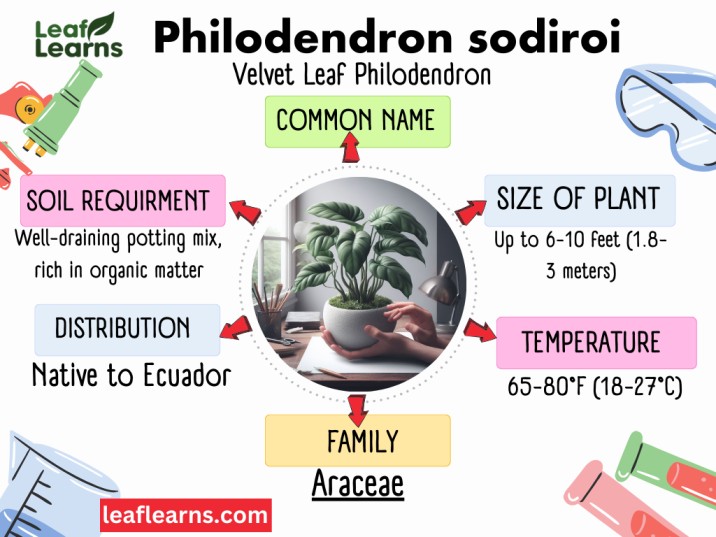
Contents
- 1 Top Care Tips
- 2 Care for Philodendron sodiroi
- 3 Propagating Philodendron sodiroi
- 4 How to Grow Philodendron-Sodiroi from Seed
- 5 Pruning
- 6 Repotting Philodendron-sodiroi
- 7 How to Get Philodendron-sodiroi to Bloom
- 8 Growth Rate and Size
- 9 Flowering and Foliage
- 10 Philodendron-sodiroi Appearance
- 11 Overwatering and Underwatering
- 12 Overwintering
- 13 Common Pests
- 14 Plant Diseases
- 15 Problems and Solutions
- 16 Toxicity of Philodendron-sodiroi
- 17 Pets
- 18 Varieties/Types
- 19 Uses for Philodendron-sodiroi
- 20 About Philodendron-Sodiroi: Successful Care and Cultivation
- 21 Conclusion
- 22 FAQs
Top Care Tips
Ideal Lighting: For optimum growth and colorful leaves, place your Philodendron-sodiroi in bright, indirect light. Avoid direct sunlight.
Proper Watering Procedure: Water thoroughly when the top inch of soil feels dry, changing frequency dependent on humidity levels. Keep the soil constantly wet but not soggy.
Plant in a well-draining soil mixture that is rich in organic matter to encourage root health and general vigor.
Maintain High Humidity: This plant thrives in high humidity; to establish the optimal environment, spray the leaves frequently or use a humidity tray.
Regular Pruning and Maintenance: For a Philodendron-sodiroi to look good and be healthy, trim to manage growth and form and remove dead leaves.
Care for Philodendron sodiroi
Light Requirement
It’s essential to satisfy Philodendron-sodiroi’s light needs for the best maintenance. Give your plant a bright, indirect area of light. As it might injure the plant, stay out of the direct sun.

With the proper amount of light, this tropical beauty may flourish.
Water Requirements
Keep the soil continually damp, not drenched, to satisfy the Philodendron-sodiroi’s thirst for water. Water as soon as the top inch feels dry, varying the frequency according to the humidity. To avoid root rot, avoid overwatering.
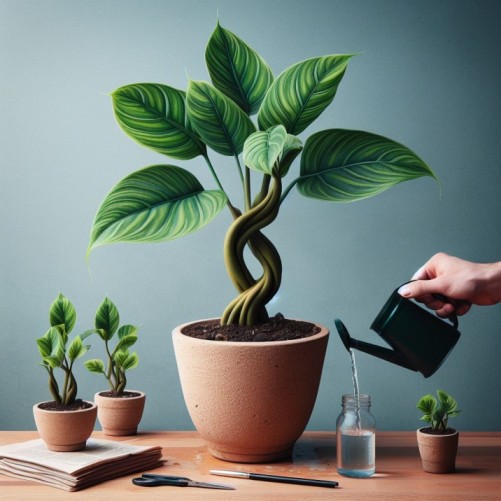
Use a potting mixture that drains effectively and ensures good drainage.
Soil Requirement
Pay particular attention to the soil requirements of your Philodendron-sodiroi to guarantee correct upkeep. This exotic beauty thrives in potting soil that drains well and contains additional organic content.
Proper root health and vigor are guaranteed by suitable soil. To avoid soggy circumstances, choose soil that readily absorbs water.
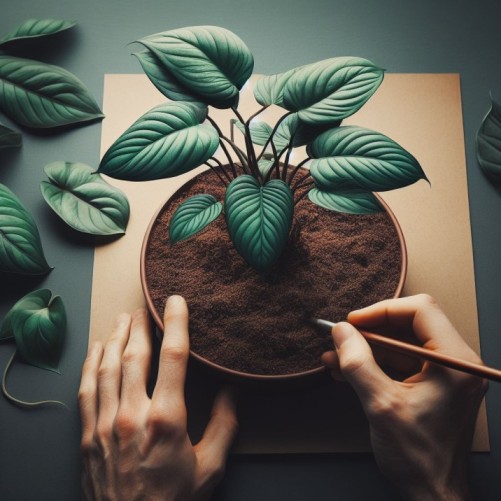
Temperature Requirement
Pay attention to the Philodendron-sodiroi’s temperature needs to make sure it grows well. This tropical plant thrives in conditions that are between 65 and 80 degrees Fahrenheit (18 and 27 degrees Celsius).
Keep it away from extremely cold or draughty areas since these might stunt its development.
Your sodiroi plant will remain healthy and content if the room is kept at a moderate temperature, letting its rich, velvety leaves to grow in your home.
Humidity Requirement
It’s critical to adhere to Philodendron-sodiroi’s humidity needs for the best care possible. This tropical plant thrives in conditions with high relative humidity, usually 50% or more.
Regular misting of the leaves or the placement of a humidity tray close by can help sustain these optimal conditions.
Fertilizer Requirement
It’s essential to satisfy your Philodendron-sodiroi’s fertilizer needs if you want to take good care of it. When given balanced liquid fertilizer during the growth season, these tropical plants flourish.
This encourages robust growth and guarantees luxuriant foliage. However, keep in mind that excessive fertilization might damage your plant.
Potting Requirement
It’s essential to adhere to your Philodendron-sodiroi’s potting needs if you want to effectively care for it. Pick a potting mix that drains well and is high in organic matter, since this will provide vital nutrients for healthy development.
To avoid waterlogging, make sure your pot has drainage holes. Also, don’t forget to repot your plant as needed to meet its expanding growth.

Propagating Philodendron sodiroi
Stem Cuttings Propagation
- Choose a stem that is mature, robust, and has at least two leaves.
- Just below a node (the little bump where leaves or roots sprout), cut the stem.
- For the cutting to develop a callus, let it air dry for a few hours.
- Bury the node in the potting mix before planting the cutting.
- To promote root growth, maintain high humidity and bright, indirect light.
- Once the plant has developed roots, which usually takes a few weeks, transplant it.
Air Layering Propagation
- Make a shallow cut in a mature, healthy stem of your choice.
- Dust some rooting hormone over the cut region.
- Sphagnum moss should be used to cover the cut area, and it should be sealed with foil or plastic wrap.
- Ensure high humidity levels and constant moisture for the moss.
- Cut the stem below the rooted piece after roots have formed (typically in a few months), and then plant it in a different container.
Division Propagation
- Remove the plant’s pot gently.
- The root ball should be divided into smaller parts, each with a few stems and roots.
- Divided pieces should be planted in separate pots with well-draining soil.
- Each young plant should get adequate care, including plenty of water.
Water Propagation
- Take a node-equipped healthy stem cutting.
- Put the cutting in a water-filled container, making sure the node is immersed.
- To avoid stagnation, the water should be changed often.
- Transplant the cutting into the ground after the roots have grown.
Leaf Cuttings Propagation
- Choose a mature leaf, then cut it into parts with a vein in each.
- Inject rooting hormone into the cut end.
- Place the parts in a potting mixture that drains properly.
- Maintain humidity while illuminating with direct, bright light.
- When fresh growth begins, transplant.
How to Grow Philodendron-Sodiroi from Seed
A satisfying procedure is starting this plant from seed. To begin, gather mature seeds from a robust plant. Shallowly bury them in a soil mixture that drains nicely.
Ideally, keep the temperature between 70 and 80 °F (21-27 °C) and maintain constant wetness. It might take weeks or months for seeds to germinate.
Once seedlings have grown, give them bright, indirect light and take care of them as you would any other philodendron.
Pruning
For the health and aesthetics of your Sodiroi plant, pruning is essential. Trim the plant frequently to keep its size and form under control.

In order to promote new development, remove any yellowing or dead leaves.Keep in mind that maintaining a well-pruned plant improves its appearance and general health, making it a lovely addition to your interior environment.
Repotting Philodendron-sodiroi
- Repot your this plant every two to three years to avoid root crowding.
- Proper Pot Size: To allow for growth, use a somewhat bigger pot with sufficient drainage.
- Fresh Soil: To develop strong roots, use a well-draining, nutrient-rich potting soil.
- Gentle Handling: To prevent harm to the plant while repotting, handle it gently.
- After repotter, water thoroughly and let the plant acclimatize.
How to Get Philodendron-sodiroi to Bloom
It’s delightful to see your Philodendron-sodiroi blossom. Make sure it is in an appropriate setting with indirect light, balanced humidity, and a regular watering schedule to promote flowering.
During the growth season, use a balanced liquid fertilizer to supply vital nutrients. To direct energy into creating flowers, remove any dead or yellowing leaves.
Growth Rate and Size
The environment and care given to the Philodendron-sodiroi affect its development rate and size. It typically has huge, heart-shaped leaves and may reach heights of 6 to 10 feet.
It’s important to remember that growth could take some time and that the size can be controlled by trimming.
Provide bright, indirect light and maintain a regularly damp but not soggy soil to promote healthy development.
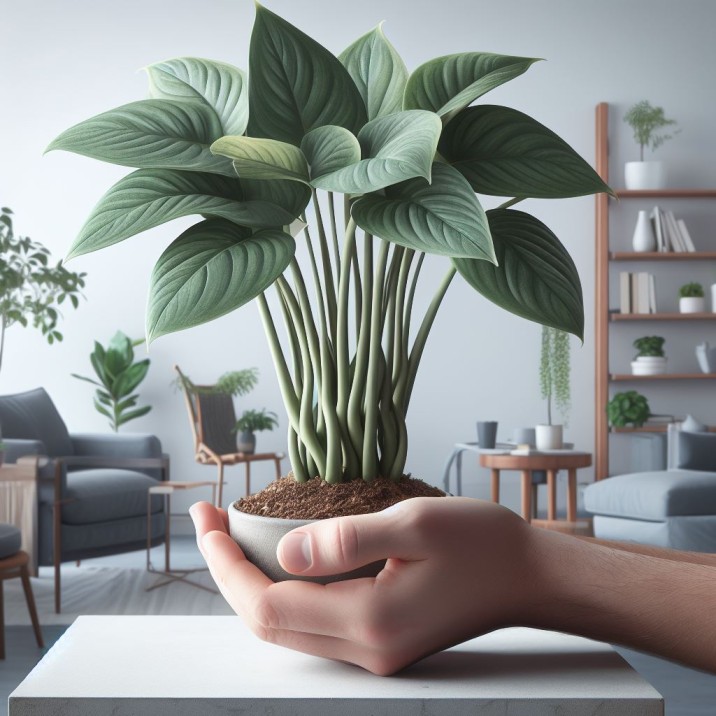
Flowering and Foliage
An intriguing combination of luxuriant foliage and sporadic flowers is provided by Philodendron-sodiroi. It is a beautiful foliage plant with heart-shaped, vivid green leaves that have white to silver veins.
Although it isn’t particularly recognized for its flowers, you may still see tiny, little flowers when it bloom.
But its dense, velvety foliage is what really draws attention, making it a popular option for indoor gardens and bringing a touch of tropical elegance to any room.
Philodendron-sodiroi Appearance
It has eye-catching aesthetics thanks to its huge, heart-shaped leaves with brilliant white or silver veins and dark green coloring.
This tropical plant is a striking accent that adds elegance and beauty to any interior setting. It is a favorite among plant aficionados due to its velvety texture and distinctive leaf.
Overwatering and Underwatering
It is possible to overwater and underwater your Sodiroi plant. Keeping the roots moist and hydrated leads to yellow leaves and root rot. Underwatering causes dry, crispy leaves and stunted growth. Maintaining good drainage and using an aerated potting mix will help you keep your plant thriving and displaying its lush, vibrant foliage. By finding this sweet spot, you will keep it thriving.
Overwintering
To successfully overwinter Philodendron-sodiroi, care must be tailored to the plant’s seasonal requirements. Place it in a warm, well-lit area away from draughts and chilly windows as the weather becomes colder.
To avoid root rot, water less often, but spray plants to keep the humidity level high. These actions guarantee that your plant remains healthy throughout the winter.
Common Pests
Beautiful indoor plants like Philodendron-sodiroi are susceptible to pests like mealybugs and spider mites. These little invaders graze on its thick vegetation, possibly degrading its beauty and well-being.
Regularly check your plant for pests, cut off any infected leaves, and treat with neem oil or insecticidal soap. To keep your sodiroi plant pest-free and flourishing, keep your surroundings tidy.
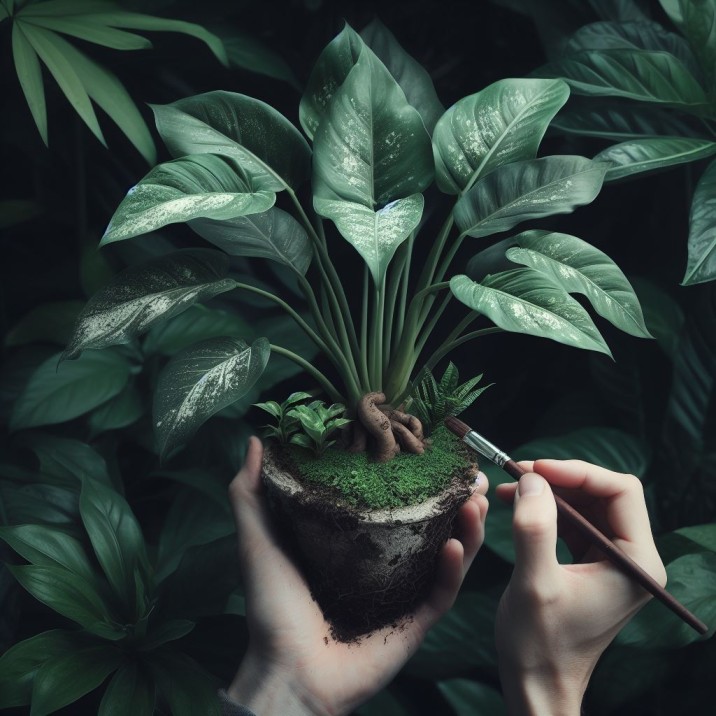
Plant Diseases
- Brown stains on leaves are indicative of a leaf spot, which is frequently brought on by overwatering. Make careful to water your plants properly.
- Root rot is caused by wet soil; pick a combination that drains well and use moderate watering.
- Pests: Keep an eye out for mealybugs and spider mites, and use neem oil or insecticidal soap to treat them.
- Yellowing Leaves: This might be a sign of nutritional inadequacy or insufficient lighting; take appropriate care.
Problems and Solutions
Problem: Yellowing Leaves
Solution: Make lighting adjustments, offer indirect light, and rotate the plant frequently.
Problem: Overwatering
Solution: Between watering, let the soil dry; make sure there is enough drainage.
Problem: Pest Infestation (e.g., mealybugs)
Solution: Neem oil or insecticidal soap can be used to treat; and isolate the damaged plant.
Problem: Slow Growth
Solution: During the growth season, apply balanced fertilizer and keep the appropriate humidity levels.
Problem: Brown Leaf Tips
Solution: Increase humidity; trim affected tips with clean scissors.
Toxicity of Philodendron-sodiroi
While a lovely addition to your indoor garden, philodendron-sodiroi needs to be handled carefully. If consumed, this plant is poisonous to both people and animals.
Make sure your pets can’t get to it and don’t let them chew on the leaves. Ingestion signs might include irritability, drooling, and stomach pain.
Pets
Pets like cats and dogs occasionally show an interest in houseplants, such as Philodendron-sodiroi. Because it is hazardous if consumed, it is imperative to keep this beautiful plant out of their line of sight.
Put it somewhere where your furry pals can’t eat the leaves.

Varieties/Types
Philodendro–Sodiroi True Form: The classic form, known for its heart-shaped leaves with silvery veins.
Philodendron-Sodiroi Aff: A variant with unique characteristics, such as different leaf shapes or coloration.
Philodendron-Sodiroi Variegated: Features leaves that have beautiful white or cream designs and add beauty to your collection.
Philodendron-Sodiroi Giant Silver: It stands out as an option because to its bigger size and shiny, silver-colored leaves.
Philodendron-Sodiroi Small Form:This species, which is ideal for tiny places, exhibits compact growth without sacrificing its magnificent beauty.
Philodendron-Sodiroi Hybrid: Intriguing hybrids of Philodendron species provide unusual, eye-catching leaves.
Philodendron-Sodiroi Climber or Crawler: A variety of varieties are available for your indoor garden, some of which have climbing inclinations and others which stay low and spread.
Philodendron-Sodiroi Moss Pole: flourishing when given a moss pole to use as support, improving its development and attractiveness.
Philodendron-Sodiroi Variegated Virus: This variety should be avoided as its variegation may be susceptible to viral illnesses.
Uses for Philodendron-sodiroi
- This plant is a popular indoor ornamental plant that adds beauty to interior areas with its rich and distinctive leaves.
- Air purification: By removing pollutants and releasing oxygen, it contributes to an improvement in indoor air quality, like other houseplants.
- Its huge, heart-shaped leaves, which have a velvety feel, give decorative flair and visual appeal to homes, workplaces, and commercial settings.
- Interior Design: To create a tropical or contemporary atmosphere, interior designers frequently include sodiroi plant in their designs.
- Natural Divider: Its bushy growth habit may be utilised to divide spaces into compartments or to mark off certain places, bringing some greenery to open areas.
- Low Maintenance: Due to its comparatively low maintenance requirements, it is perfect for people with hectic schedules or those new to plant care.
- Stress Reduction: Caring for indoor plants like Philodendron-sodiroi can have a calming and therapeutic effect, reducing stress and enhancing well-being.
- Gifts: It makes for a thoughtful and enduring gift for various occasions, symbolizing growth and prosperity.
- Botanical Interest: Enthusiasts and collectors appreciate Philodendron-sodiroi for its unique traits and contribution to their plant collections.
- Propagation: It can be a source of cuttings for propagation, allowing plant lovers to share and expand their greenery.
- Education: Philodendron-sodiroi serves as an educational tool, helping people learn about tropical plants and their care.
About Philodendron-Sodiroi: Successful Care and Cultivation
Caring for sodiroi plant, a rare and striking hybrid variety, requires attention to several key factors. To successfully care for this giant silver Philodendron, start with its light and water needs. Place it in a well-lit spot, ensuring it receives enough indirect sunlight while being cautious to avoid overexposure.
Maintain consistently moist but not waterlogged soil, allowing for proper drainage. Its growth rate can be impressive when provided with proper care. Propagation can be done through stem cuttings, and its mature form is truly remarkable.
Keep in mind the differences between Philodendron mamei and sodiroi if you plan to grow both varieties. Some enthusiasts even opt for a Philodendron-sodiroi moss pole or support to encourage its climbing tendencies.
In Australia and Canada, obtaining this hybrid plant may involve a search at specialty nurseries or gardening centers, such as Bunnings.
Conclusion
Finally, taking care of your Philodendron-sodiroi entails attending to all of its unique requirements, from soil and humidity to light and water. Your sodiroi may flourish and adorn your interior area with its rich leaves if you provide the ideal circumstances and adhere to a few important maintenance instructions.
To keep your plant healthy and bright, stay up with routine trimming, repot as necessary, and keep an eye out for any pests or illnesses. Furthermore, the adaptability, visual appeal, and air-purifying qualities of Philodendron-sodiroi make it a perfect choice for beautifying your living environment, providing both beauty and well-being advantages.
This magnificent tropical plant is guaranteed to be a gratifying addition to your collection, whether you’re an experienced plant enthusiast or a novice in the world of indoor gardening.
FAQs
What are the light conditions for Philodendron sodiroi?
Since direct sunlight might kill the plant, Philodendron-sodiroi needs strong, indirect light to grow and flourish. Healthy growth and colorful foliage are ensured by proper illumination.
How should you water your Philodendron sodiroi to maintain its health?
Maintaining a constant moisture level in the soil that isn’t saturated is crucial. To avoid overwatering and root rot, water thoroughly when the top inch of soil feels dry, adjusting frequency based on humidity conditions.
What type of soil mix is best for Philodendron sodiroi?
A mix that drains well and is enriched with organic materials is ideal for Philodendron-sodiroi. This kind of soil prevents water logging and supports healthy development by promoting root health and general vigor.
What are the temperature for Philodendron sodiroi?
The preferred temperature range for Philodendron-sodiroi is 65–80°F (18–27°C). Its development might be harmed by extreme cold or droughts, thus keeping the space at a healthy temperature is crucial for its health.
How can you meet the humidity requirements of Philodendron sodiroi?
In areas with high humidity (about 50% or greater), Philodendron-sodiroi flourishes. Using a humidity tray or routinely spraying the leaves can help you keep the proper conditions. Leaf browning and dryness are difficulties that may be avoided with enough humidity.
What is the fertilizer schedule for Philodendron sodiroi, and why should you avoid over-fertilizing?
During the growth season, balanced liquid fertilizer is beneficial. It’s crucial to follow a regular feeding schedule using a diluted, balanced fertilizer since over fertilizing might damage the plant.
What potting should you consider for Philodendron sodiroi?
Make sure your container has drainage holes and choose a potting mix that drains well and is rich in organic materials. Your sodiroi plant will flourish as a result of the strong growth and water logging prevention this encourages.
Is Philodendron sodiroi is rare?
Yes, Due to its unusual and distinctive look, Philodendron-sodiroi is regarded as a rare and sought-after plant species by collectors and enthusiasts, making it a treasured addition to plant collections.

